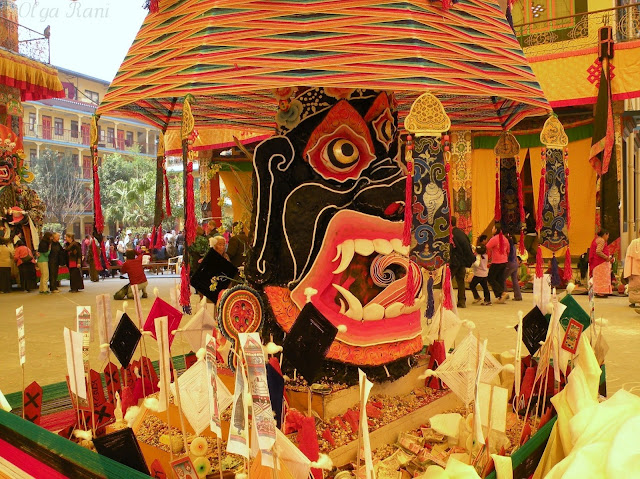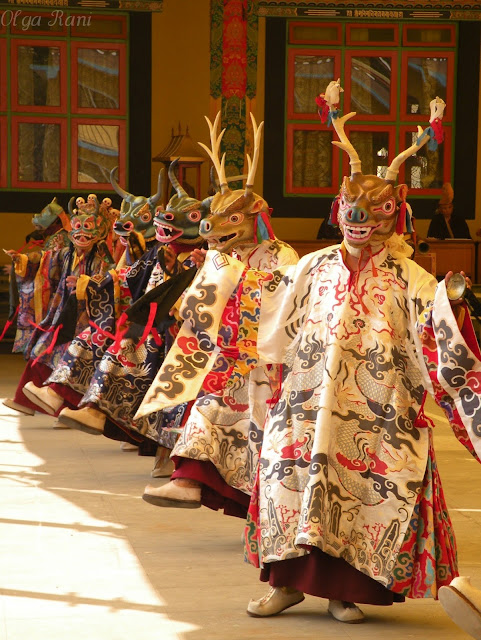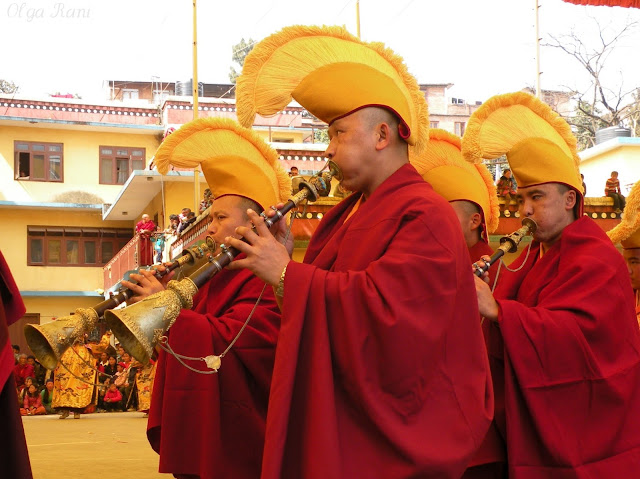
Today is Losar, the Tibetan New Year, and the day before it the Tibetans celebrated Gutor. On this day the whole house is cleaned, the new curtains are hang on the windows and new material is bought to make quilt covers and clothes. The house is decorated with eight auspicious signs, which include conch shells, dharma wheels and eternal knots. Women cook special New Year's pastries khabtse which are left as offering at the temple and given to visitors. A special soup guthuk is also cooked on this day. It consists of nine components: meat, wheat, rice, sweet potatoes, cheese, peas, green pepper, noodles and radishes. Unusual dumplings are put in the soup: they may be stuffed with stone, wood, paper, rice, coal, symbolic images of moon and sun, wool. Depending on what dumpling the person gets, his/her future for the coming year is "predicted". For example, a dumpling with a piece of coal means an unpleasant encounter with a man who is able to ruin one's life. But a rice dumpling promises good luck.


After the meal, the eldest member of the family rubs a ball of dough over each family member to draw out all the illnesses they have suffered over the year. The ball and the collected house dust then is carried across the road and thrown in a fire. The sweeping of the dust symbolizes the family's ridding the house of demons. On the day of Gutor the ritual dances of lamas, cham, are performed at the monasteries. The purpose of cham is to clear obstacles. There are three types of obstacles: outer, inner, and innermost. Outer obstacles are such things as famine, sickness, and all sorts of inconveniences of life. Inner obstacles are hatred, pride, jealousy and similar negative emotions. Innermost or secret obstacles are what Buddhists call conceptual obscurations. These prevent one from seeing things as they truly are, from seeing the path to enlightenment.



The performance takes a few hours and consists of four parts: pacification and neutralization, subjugating and destruction. Pacification is the effectuations of the obstacles into one’s presence. Neutralization is the process of offering to the obstacles so that they have a substitute for their aggression. Subjugating is threatening the obstacles with destruction should they not obey, represented in the dancing by displaying a series of weapons. Finally, destruction culminates in shooting an arrow of fire into a large torma that contains all obstacles.



Dancing is rather slow, performed to the accompaniment of drums and cymbals, and sometimes they are joined by trumpet and singing of the Lama. All dancers are in bright costumes and masks that represent different deities and animals. Costumes for ritual dances are usually sewn from brocade and silk. Wide sleeves of the dresses are shaped like a quiver which symbolizes that the gods concealed a bow and arrows inside the sleeves and at any time will be able to hit enemies.
The masks are made of wood or papier-mache and painted. The hair is traditionally made of yak tails. The mask is often two to three times the size of a human face, so the monks who perform dances, do not look through the eyes, but through the nostrils and mouth. In the hands of everyone dancing there are a variety of subjects: a spear, a sword, a flag, a snake, a trident, a scepter with a knob shaped like a skull, a cup. Manipulation of these objects during the dance has a special meaning.
In between dances the audience is entertained by comic characters, atsara - a kind of clowns. They fool around making jokes to each other and to spectators, trying to make everybody laughing.
I watched these ritual dances at the Benchen monastery (near Swayambhu). In addition to adult monks children also took part in yesterday's performance, although their entrance was short.
The dances started around 10 am. Then there was a free lunch for the monks and for all who came to the show. Then the performance went on until the evening.
No comments:
Post a Comment